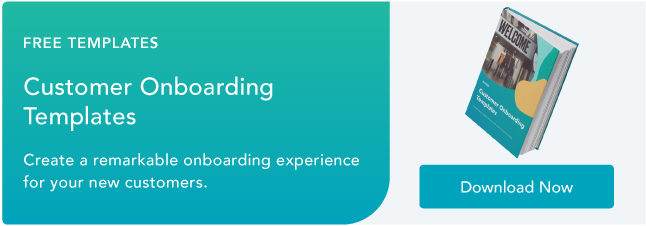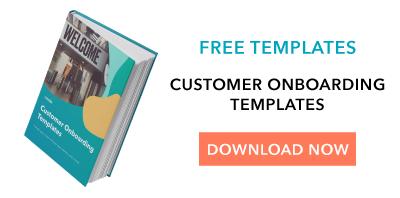
However, customer acquisition isn’t where the work ends. Rather, it’s just getting started. It’s much easier for customers to churn at the beginning of the relationship when they feel no loyalty or investment in your business.
[Free Download] Create a remarkable experience for your new customers with our Customer Onboarding Templates.
This is where an onboarding process enters the picture. With onboarding, you can ensure customers master your product or service before they get frustrated and fed up. And, you can use this opportunity to strengthen your relationship with them so they stay loyal to your company over time, creating opportunities for you to upsell and cross-sell.
Let’s discuss a step-by-step onboarding process you can implement at your business. Then, we’ll provide a questionnaire template that can help you identify customer needs.
The 5-Step Client Onboarding Process
1. Establish the client.
Before doing anything, you should legally establish the client with your company. That means writing up a proposal for the project, building a contract, and setting up payment for your work.
This step is important because it ensures the client is bound to your agreement and that you’re not doing work for free. Also, the proposal will set clear guidelines for the work you’ll be doing.
2. Understand your client’s goals.
Even if you already have an idea of what the client hopes to accomplish, you should always have them directly explain their goals. You can do this with a client onboarding questionnaire (template below) that asks customers all the questions you have about the project.
Using this questionnaire, you can turn your client’s answers into actionable team goals. Make sure everyone on your team is aware of each step and deadline and use this time to assign a lead contact for the project based on who can best meet the client’s needs.
3. Schedule a kickoff meeting.
Once a plan is laid out, it’s time for the kickoff meeting. This is your chance to introduce your client to the team and get everyone excited about the project.
This meeting should set a confident tone by making it clear to the client that they put their trust in the right team. While this is a time for introductions, it’s also a time to show the work that’s already completed. Relay your business goals, timeline, lead contact, and step-by-step responsibilities to prove to your client that you’re prepared and ready to go.
4. Officially welcome the client.
Once the kickoff meeting is completed, you should formally welcome the client to your business. Send them a welcome package with a personalized note, video, and even some branded merchandise. This will act as proactive customer service and it’ll let the customer share their experience with others.
Additionally, you should provide any other important documents and information that the client may need moving forward. This includes details about your business, like contact information, business hours, location, as well as reassuring documents like client testimonials and case studies. These resources make new customers feel more comfortable and further reassures their investment in your business.
5. Plan a check-in call after 30 days.
After 30 days, your team should check in with your client. By this time, your plan has been sufficiently tested and your client will have a good feel for your team’s progress.
Use this time to give your client feedback on how the onboarding is going. Ask them any additional questions and address any of the client’s concerns. Take this call seriously as the more genuine you are about hearing and responding, the less likely they are to churn.
Now that we understand each step of the client onboarding process, let’s focus on step two by building an onboarding questionnaire.
New Client Onboarding Questionnaire
A client onboarding questionnaire is a survey sent to new customers to get more information about their needs and goals. Businesses use this form to ask about specific details and ensure they’re team is achieving exactly what the client wants.
You can use a free or paid online survey maker to create this questionnaire. These providers let you ask as many questions as you’d like and create a survey design that aligns with your brand’s image.
However, when creating your questionnaire, don’t go overboard with adding questions. After all, you don’t want to give new clients too much work to do. So, only include questions that your team needs to know the answer to. While customer feedback is great, there’s another time and place to ask for that information.
Below, we’ve curated a list of the best questions you can ask clients in an onboarding questionnaire.
New Client Onboarding Questionnaire Template
Basic Client Information
- Who’s the main point of contact at your business?
- What’s their contact information?
- What’s your business address?
- What’s your website URL?
- Are there any documents about your business that we should read and keep on-hand? If so, attach them here:
Marketing Information
- What are your brand’s goals and vision?
- Who are your main competitors?
- Who’s your target audience?
Project-Specific Information
- What are your overarching goals for this project?
- What specific metrics can we use to measure success for this project?
- What’s your budget for this project?
- What’s your deadline for the project?
- Have you worked with a similar company in the past? If so, what were the company, project, and results?
Business Information
- How did you hear about our business?
- Why did you select our business for this project?
- What more can our team do to ensure this is a smooth, satisfactory process for you?
For a smoother onboarding process, read about the sales to service handoff.
Originally published Sep 18, 2019 8:00:00 AM, updated September 19 2019
Topics:




